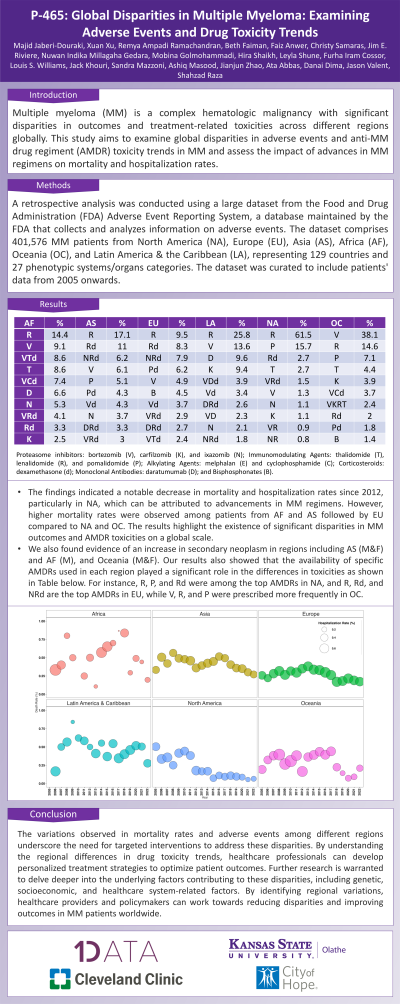QoL and Patient-Reported Outcome and Supportive Care
Poster Session 3
P-465: Global Disparities in Multiple Myeloma: Examining Adverse Events and Drug Toxicity Trends
Friday, September 29, 2023
1:15 PM - 2:15 PM EEST


Majid Jaberi-Douraki, PhD
Associate Professor
Kansas State University
SHAWNEE, Kansas, United States
Introduction: Multiple myeloma (MM) is a complex hematologic malignancy with significant disparities in outcomes and treatment-related toxicities across different regions globally. This study aims to examine global disparities in adverse events and drug toxicity trends in MM and assess the impact of advances in MM regimens on mortality and hospitalization rates.
Methods: A retrospective analysis was conducted using a large dataset from the Food and Drug Administration (FDA) Adverse Event Reporting System, a database maintained by the FDA that collects and analyzes information on adverse events. The dataset comprises 401,576 MM patients from North America (NA), Europe (EU), Asia (AS), Africa (AF), Oceania (OC), and Latin America & the Caribbean (LA), representing 129 countries and 27 phenotypic systems/organs categories. The dataset was curated to include patients' data from 2005 onwards.
Results: The findings indicated a notable decrease in mortality and hospitalization rates since 2012, particularly in NA, which can be attributed to advancements in MM regimens. However, higher mortality rates were observed among patients from AF and AS followed by EU compared to NA and OC. The results highlight the existence of significant disparities in MM outcomes and AMDR toxicities on a global scale. We also found evidence of an increase in secondary neoplasm in regions including AS (M&F) and AF (M), and Oceania (M&F). Our results also showed that the availability of specific AMDRs used in each region played a significant role in the differences in toxicities as shown in Table below. For instance, R, P, and Rd were among the top AMDRs in NA, and R, Rd, and NRd are the top AMDRs in EU, while V, R, and P were prescribed more frequently in OC.
AF % AS % EU % LA % NA % OC %
R 14.4 R 17.1 R 9.5 R 25.8 R 61.5 V 38.1
V 9.1 Rd 11 Rd 8.3 V 13.6 P 15.7 R 14.6
VTd 8.6 NRd 6.2 NRd 7.9 D 9.6 Rd 2.7 P 7.1
T 8.6 V 6.1 Pd 6.2 K 9.4 T 2.7 T 4.4
VCd 7.4 P 5.1 V 4.9 VDd 3.9 VRd 1.5 K 3.9
D 6.6 Pd 4.3 B 4.5 Vd 3.4 V 1.3 VCd 3.7
N 5.3 Vd 4.3 Vd 3.7 DRd 2.6 N 1.1 VKRT 2.4
VRd 4.1 N 3.7 VRd 2.9 VD 2.3 K 1.1 Rd 2
Rd 3.3 DRd 3.3 DRd 2.7 N 2.1 VR 0.9 Pd 1.8
K 2.5 VRd 3 VTd 2.4 NRd 1.8 NR 0.8 B 1.4
Proteasome inhibitors: bortezomib (V), carfilzomib (K), and ixazomib (N); Immunomodulating Agents: thalidomide (T), lenalidomide (R), and pomalidomide (P); Alkylating Agents: melphalan (E) and cyclophosphamide (C); Corticosteroids: dexamethasone (d); Monoclonal Antibodies: daratumumab (D); and Bisphosphonates (B).
Conclusions: The variations observed in mortality rates among different regions underscore the need for targeted interventions to address these disparities. By understanding the regional differences in drug toxicity trends, healthcare professionals can develop personalized treatment strategies to optimize patient outcomes. Further research is warranted to delve deeper into the underlying factors contributing to these disparities, including genetic, socioeconomic, and healthcare system-related factors.
Methods: A retrospective analysis was conducted using a large dataset from the Food and Drug Administration (FDA) Adverse Event Reporting System, a database maintained by the FDA that collects and analyzes information on adverse events. The dataset comprises 401,576 MM patients from North America (NA), Europe (EU), Asia (AS), Africa (AF), Oceania (OC), and Latin America & the Caribbean (LA), representing 129 countries and 27 phenotypic systems/organs categories. The dataset was curated to include patients' data from 2005 onwards.
Results: The findings indicated a notable decrease in mortality and hospitalization rates since 2012, particularly in NA, which can be attributed to advancements in MM regimens. However, higher mortality rates were observed among patients from AF and AS followed by EU compared to NA and OC. The results highlight the existence of significant disparities in MM outcomes and AMDR toxicities on a global scale. We also found evidence of an increase in secondary neoplasm in regions including AS (M&F) and AF (M), and Oceania (M&F). Our results also showed that the availability of specific AMDRs used in each region played a significant role in the differences in toxicities as shown in Table below. For instance, R, P, and Rd were among the top AMDRs in NA, and R, Rd, and NRd are the top AMDRs in EU, while V, R, and P were prescribed more frequently in OC.
AF % AS % EU % LA % NA % OC %
R 14.4 R 17.1 R 9.5 R 25.8 R 61.5 V 38.1
V 9.1 Rd 11 Rd 8.3 V 13.6 P 15.7 R 14.6
VTd 8.6 NRd 6.2 NRd 7.9 D 9.6 Rd 2.7 P 7.1
T 8.6 V 6.1 Pd 6.2 K 9.4 T 2.7 T 4.4
VCd 7.4 P 5.1 V 4.9 VDd 3.9 VRd 1.5 K 3.9
D 6.6 Pd 4.3 B 4.5 Vd 3.4 V 1.3 VCd 3.7
N 5.3 Vd 4.3 Vd 3.7 DRd 2.6 N 1.1 VKRT 2.4
VRd 4.1 N 3.7 VRd 2.9 VD 2.3 K 1.1 Rd 2
Rd 3.3 DRd 3.3 DRd 2.7 N 2.1 VR 0.9 Pd 1.8
K 2.5 VRd 3 VTd 2.4 NRd 1.8 NR 0.8 B 1.4
Proteasome inhibitors: bortezomib (V), carfilzomib (K), and ixazomib (N); Immunomodulating Agents: thalidomide (T), lenalidomide (R), and pomalidomide (P); Alkylating Agents: melphalan (E) and cyclophosphamide (C); Corticosteroids: dexamethasone (d); Monoclonal Antibodies: daratumumab (D); and Bisphosphonates (B).
Conclusions: The variations observed in mortality rates among different regions underscore the need for targeted interventions to address these disparities. By understanding the regional differences in drug toxicity trends, healthcare professionals can develop personalized treatment strategies to optimize patient outcomes. Further research is warranted to delve deeper into the underlying factors contributing to these disparities, including genetic, socioeconomic, and healthcare system-related factors.
